Many website projects start with technical questions: What functions should the site have, which CMS should we use, and how to design the user interface? Yet it quickly becomes clear that many website projects are fundamentally content-driven. A website is primarily a communication tool. What truly matters is not only how a site looks or how technically advanced it is, but also how effectively it communicates.
Content determines success
For this reason, content should be central to most website projects. At the outset, key questions arise:
- What do we actually want to communicate?
- How can we communicate these messages successfully?
These questions should form the starting point of any web project. User research merges internal objectives with user needs, creating the basis for content development.
However, effective communication requires more than just good content. It also needs a holistic user experience perspective, which considers every phase users go through when visiting a website. Additionally, it requires a design that optimally supports and highlights the content
Content meets design – a great team
This is precisely the intersection between the disciplines of "Content" and "Design". Specifically, content design, user experience design, and user interface design are interwoven and inseparable. Convincing content design emerges when content, interaction, and visuals are developed collaboratively and complement each other perfectly.
This is why Liip consciously offers both design and content services as a digital agency and integrates them strategically in projects.
Examples of content-design collaboration
Page templates: Clear structure meets strong content
Page templates are essential for a consistent user experience. Users appreciate not having to reorient themselves each time they visit a next page. That’s why we develop a clearly defined number of templates for your websites. A well-designed template considers content objectives from the outset: What content needs to be presented, and how can users navigate through it effectively? Content strategists and designers collaboratively ensure that templates are not only visually appealing but also flexible enough to accommodate different types of content. We define fixed and optional elements, discuss ideal text lengths, and establish a portfolio of content types for editors.
A thoughtfully designed template simplifies content production and ensures a consistent user experience.
Microcopy and interaction elements: Supporting design with words
A frequently overlooked yet crucial aspect of the content-design relationship is microcopy and interaction elements. Buttons, forms, error messages, or instructions are small yet vital components of user experience. Designers and UX writers collaboratively develop these elements to ensure intuitive navigation and effortless content comprehension. The right wording on a button or a helpful hint ensures users clearly understand what happens next—making design clearer, more understandable, and user-friendly through strategic content.
Content formats: Creative ping-pong between content and design
Developing concrete content formats—such as an info box or employee profiles—ideally begins with content: What's the core idea, and what are we trying to achieve? Yet it’s the visually appealing execution that truly brings a format to life, making it inviting and engaging. Once initial visual concepts are available, content strategists revisit and refine the ideas. Visual designs often inspire additional creative content ideas. Through an iterative process of creative exchange between content and design, formats are created where content and visuals ideally complement each other.
Benefits of integrated collaboration
When clients purchase content and design services together from Liip, they benefit in numerous ways:
- Short communication channels and cohesive teams: Our content strategists and designers regularly collaborate closely, ensuring cohesive teams and minimal coordination effort for our clients.
- Joint development: Content and design are developed collaboratively from the outset, ensuring formats and page types work effectively in practice.
- Efficiency and quality: Because our designers understand content processes well, they create designs optimized for content goals from the start.
Risks of working with separate agencies
These benefits diminish when content and design services are separated—such as assigning design to another agency while Liip handles content:
- Additional exchange often arise since other agencies may be less familiar with content objectives.
- Coordination efforts increase, and processes become less streamlined.
- Ultimately, this can result in higher costs and lower quality across multiple dimensions.
Conclusion
For website projects where communication objectives are central, it pays off to source content and design together from Liip. Our clients benefit from efficient processes, high quality, and a robust foundation for future content production.
Would you like to learn more about how we optimally integrate content and design? Feel free to contact us or explore our other blog posts on successful digital projects.

